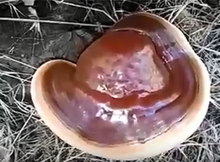| Ganoderma lucidum | |
|---|---|

| |
| Ganoderma growing under oak in California[1] | |
| Scientific classification | |
| Domain: | Eukaryota |
| Kingdom: | Fungi |
| Division: | Basidiomycota |
| Class: | Agaricomycetes |
| Order: | Polyporales |
| Family: | Ganodermataceae |
| Genus: | Ganoderma |
| Species: | G. lucidum
|
| Binomial name | |
| Ganoderma lucidum Karst (1881)
| |
| Synonyms | |
|
Boletus lucidus (Curtis) Polyporus lucidus (Murrill) | |
| Ganoderma lucidum | |
|---|---|
| Pores on hymenium | |
| No distinct cap or offset | |
| Hymenium attachment is irregular or not applicable | |
| Stipe is bare or lacks a stipe | |
| Spore print is brown | |
| Ecology is parasitic | |
| Edibility is edible, but unpalatable | |
Ganoderma lucidum, commonly known as the reishi, varnished conk, or ling chih,[2] is a red-colored species of Ganoderma with a limited distribution in Europe and parts of China, where it grows on decaying hardwood trees.[3] Wild populations have been found in the United States in California and Utah but were likely introduced anthropogenically and naturalized.[1]
- ^ a b Loyd, AL; Barnes, CW; Held, BW; Schink, MJ; Smith, ME; Smith, JA; Blanchette, RA (2018). "Elucidating 'lucidum': Distinguishing the diverse laccate Ganoderma species of the United States". PLOS ONE. 13 (7): e0199738. Bibcode:2018PLoSO..1399738L. doi:10.1371/journal.pone.0199738. PMC 6051579. PMID 30020945.
- ^ Arora, David (1986). Mushrooms demystified: a comprehensive guide to the fleshy fungi (Second ed.). Berkeley: Ten Speed Press. ISBN 978-0-89815-169-5.
- ^ Loyd, Andrew L.; Richter, Brantlee S.; Jusino, Michelle A.; Truong, Camille; Smith, Matthew E.; Blanchette, Robert A.; Smith, Jason A. (16 July 2018). "Identifying the 'Mushroom of Immortality': Assessing the Ganoderma Species Composition in Commercial Reishi Products". Frontiers in Microbiology. 9: 1557. doi:10.3389/fmicb.2018.01557. PMC 6055023. PMID 30061872.